

Minotaur (Dungeons & Dragons) Gas laws. The early gas laws were developed at the end of the 18th century, when scientists began to realize that relationships between the pressure, volume and temperature of a sample of gas could be obtained which would hold for all gases.
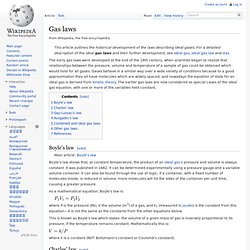
Gases behave in a similar way over a wide variety of conditions because to a good approximation they all have molecules which are widely spaced, and nowadays the equation of state for an ideal gas is derived from kinetic theory. The earlier gas laws are now considered as special cases of the ideal gas equation, with one or more of the variables held constant. Boyle's law[edit] Boyle's law shows that, at constant temperature, the product of an ideal gas's pressure and volume is always constant. It was published in 1662. As a mathematical equation, Boyle's law is:
Wind tunnel. Chemiluminescence. A chemoluminescent reaction carried out in an erlenmeyer flask producing a large amount of light Chemiluminescence (sometimes "chemoluminescence") is the emission of light (luminescence), as the result of a chemical reaction. There may also be limited emission of heat. Numa Numa (video) Numa Numa Song has since spawned many parody videos, including those created for the "New Numa Contest", sponsored by Brolsma, which promised US$45,000 in prize money for submissions.
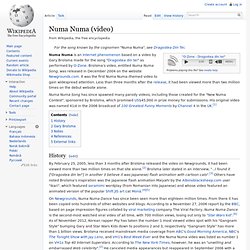
His original video was named 41st in the 2006 broadcast of 100 Greatest Funny Moments by Channel 4 in the UK.[1] By February 25, 2005, less than 3 months after Brolsma released the video on Newgrounds, it had been viewed more than two million times on that site alone.[2] Brolsma later stated in an interview, "...I found it ["Dragostea din tei"] in another (I believe it was Japanese) flash animation with cartoon cats".[3] Others have noted Brolsma's inspiration was the Japanese flash animation Maiyahi by the Albinoblacksheep.com user "ikari", which featured soramimi wordplay (from Romanian into Japanese) and whose video featured an animated version of the popular Shift JIS art cat Monā.[4][5] Gary Brolsma.
He made appearances on ABC's Good Morning America, NBC's The Tonight Show, and VH1's Best Week Ever. List of unexplained sounds. The following is a list of sounds, the sources of which remain unknown: NOAA (unidentified)[edit] The following unidentified sounds were detected by the USA National Oceanic and Atmospheric Administration using its Equatorial Pacific Ocean autonomous hydrophone array.
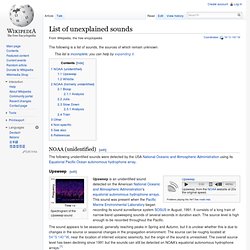
Upsweep[edit] Spectrogram of the Upsweep sound. Cosmic latte. Cosmic Latte is a name assigned to the average color of the universe, given by a team of astronomers from Johns Hopkins University.

Discovery of the color[edit] In 2001, Karl Glazebrook and Ivan Baldry determined that the color of the universe was a greenish white, but they soon corrected their analysis in a 2002 paper,[1] in which they reported that their survey of the color of all light in the universe added up to a slightly beigeish white. The survey included more than 200,000 galaxies, and measured the spectral range of the light from a large volume of the universe. The hexadecimal RGB value for Cosmic Latte is #FFF8E7.
List of common misconceptions. From Wikipedia, the free encyclopedia This incomplete list is not intended to be exhaustive.

This list corrects erroneous beliefs that are currently widely held about notable topics. Aerogel. A block of aerogel in a person's hand Aerogel was first created by Samuel Stephens Kistler in 1931, as a result of a bet with Charles Learned over who could replace the liquid in "jellies" with gas without causing shrinkage.[3][4] IUPAC definition Gel comprised of a microporous solid in which the dispersed phase is a gas.
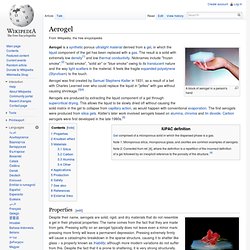
Note 1: Microporous silica, microporous glass, and zeolites are common examples of aerogels. Octave illusion. Octave illusion.
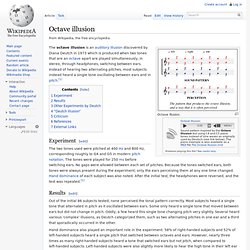
Experiment[edit] The two tones used were pitched at 400 Hz and 800 Hz, corresponding roughly to G4 and G5 in modern pitch notation. The tones were played for 250 ms before switching ears. No gaps were allowed between each set of pitches. Endoskeleton. An endoskeleton (From Greek ἔνδον, éndon = "within", "inner" + σκελετός, skeletos = "skeleton") is an internal support structure of an animal, composed of mineralized tissue.
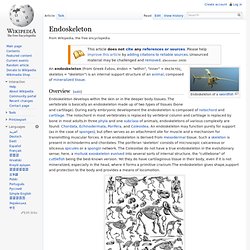
List of optical illusions. Anaerobic organism. Aerobic and anaerobic bacteria can be identified by growing them in test tubes of thioglycollate broth: 1: Obligate aerobes need oxygen because they cannot ferment or respire anaerobically. They gather at the top of the tube where the oxygen concentration is highest. 2: Obligate anaerobes are poisoned by oxygen, so they gather at the bottom of the tube where the oxygen concentration is lowest. 3: Facultative anaerobes can grow with or without oxygen because they can metabolise energy aerobically or anaerobically. They gather mostly at the top because aerobic respiration generates more ATP than either fermentation or anaerobic respiration. 4: Microaerophiles need oxygen because they cannot ferment or respire anaerobically.
However, they are poisoned by high concentrations of oxygen. Soft palate. The soft palate (also known as velum or muscular palate) is, in mammals, the soft tissue constituting the back of the roof of the mouth.

The soft palate is distinguished from the hard palate at the front of the mouth in that it does not contain bone. Structure[edit] Muscles[edit] Smile. A smile is a facial expression formed by flexing the muscles near both ends of the mouth and by flexing muscles throughout the mouth.[1] Some smiles include contraction of the muscles at the corner of the eyes (also known as 'Duchenne' smiling).

Among humans, it is an expression denoting pleasure, sociability, happiness, or amusement. This is not to be confused with a similar but usually involuntary expression of anxiety known as a grimace.
Moons and more. Robotics. Tunnel vision. Tunnel vision imitation Tunnel vision (also known as Kalnienk vision) is the loss of peripheral vision with retention of central vision, resulting in a constricted circular tunnel-like field of vision.[1] Medical / biological causes[edit] Tunnel vision can be caused by: Alien life. Tralfamadore. The Tralfamadorians are a fictional alien race mentioned in several novels by Kurt Vonnegut. Tralfamadore is their home planet. Space near earth. Parasomnia. Parasomnias are a category of sleep disorders that involve abnormal movements, behaviors, emotions, perceptions, and dreams that occur while falling asleep, sleeping, between sleep stages, or during arousal from sleep. Most parasomnias are dissociated sleep states which are partial arousals during the transitions between wakefulness and NREM sleep, or wakefulness and REM sleep. Automated Transfer Vehicle.
Roller coaster stuff. Sex articles. Caves and mines. New age and occult. Flatulence and poop stuff. Body fluids slime and other gross stuff. Respiratory articles. Watery articles. Glory (optical phenomenon) Diamond dust. Characteristics[edit] Falling diamond dust (Inari, Finland) Diamond dust is similar to fog in that it is a cloud based at the surface; however, it differs from fog in two main ways. Generally fog refers to a cloud composed of liquid water (the term ice fog usually refers to a fog that formed as liquid water and then froze, and frequently seems to occur in valleys with airborne pollution such as Fairbanks, Alaska, while diamond dust forms directly as ice).
Also, fog is a dense enough cloud to significantly reduce visibility, while diamond dust is usually very thin and may not have any effect on visibility (there are far fewer crystals in a volume of air than there are droplets in the same volume with fog). However, diamond dust can often reduce the visibility, in some cases to under 600 m (2,000 ft). Eccentric Jupiter.
Eccentric Jupiter HD 96167 b has a comet-like orbit. An eccentric Jupiter is a Jovian planet that orbits its star in an eccentric orbit.[1] Eccentric Jupiters may disqualify a planetary system from having Earth-like planets in it because a massive gas giant with an eccentric orbit may remove all Earth mass planets from the habitable zone. To date, it appears that approximately 7% of all stars (half of the known planetary systems) have an eccentric Jupiter (e > 0.1), making these planets more common than Hot Jupiters. Extravehicular Mobility Unit. Shuttle Ejection Escape Suit. Severe weather. Microburst. Hanged, drawn and quartered. Sunshower. Fairy Tale Forest. Amorphous carbonia.